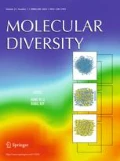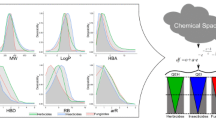Abstract
The increasing resistance of several phytopathogenic fungal species to the existing agrochemical fungicides has alarmed to the worldwide scientific community. There is no available methodology to predict in an efficient way if a new fungicide will have resistance risk due to fungal species which cause considerable crop losses. In an attempt to overcome this problem, a multi-resistance risk QSAR model, based on substructural descriptors was developed from a heterogeneous database of compounds. The purpose of this model is the classification, design, and prediction of agrochemical fungicides according to resistance risk categories. The QSAR model classified correctly 85.11% of the fungicides and the 85.07% of the inactive compounds in the training series, for an accuracy of 85.08%. In the prediction series, the percentages of correct classification were 85.71 and 86.55% for fungicides and inactive compounds, respectively, with an accuracy of 86.39%. Some fragments were extracted and their quantitative contributions to the fungicidal activity were calculated taking into consideration the different resistance risk categories for agrochemical fungicides. In the same way, some fragments present in molecules with fungicidal activity and with negative contributions were analyzed like structural alerts responsible of resistance risk.
Similar content being viewed by others
References
Plimmer JR, Gammon DW, Ragsdale NN (2003) Encyclopedia of agrochemicals. Wiley, Hoboken
Brent KJ, Hollomon DW (2007) Fungicide resistance in crop pathogens: how can it be managed? FRAC Monograph No. 1, second revised edn. Fungicide Resistance Action Committee, CROPLIFE INTERNATIONAL, Brussels. Available at: http://www.frac.info/frac/publication/publication.htm. Accessed on 2 Jan 2011
Li M, Liu CL, Li L, Yang H, Li ZN, Zhang H, Li ZM (2009) Design, synthesis and biological activities of new strobilurin derivatives containing substituted pyrazoles. Pest Manag Sci 66: 107–112. doi:10.1002/ps.1837
Lopez-Ruiz FJ, Perez-Garcia A, Fernandez-Ortuno D, Romero D, de Garcia E, Vicente A, Brown JK, Tores JA (2010) Sensitivities to DMI fungicides in populations of Podosphaera fusca in south central Spain. Pest Manag Sci 66: 801–808. doi:10.1002/ps.1948
Bolboacă SD, Jäntschi L (2007) Modelling the inhibition activity on carbonic anhydrase I of some substituted thiadiazole- and thiadiazoline-disulfonamides: integration of structure information. Comput Aided Chem Eng 24: 965–970. doi:10.1016/S1570-7946(07)80185-4
Khambay BP, Batty D, Jewess PJ, Bateman GL, Hollomon DW (2003) Mode of action and pesticidal activity of the natural product dunnione and of some analogues. Pest Manag Sci 59: 174–182. doi:10.1002/ps.632
Du H, Wang J, Hu Z, Yao X, Zhang X (2008) Prediction of fungicidal activities of rice blast disease based on least-squares support vector machines and project pursuit regression. J Agric Food Chem 56: 10785–10792. doi:10.1021/jf8022194
Balba H (2007) Review of strobilurin fungicide chemicals. J Environ Sci Health B 42: 441–451. doi:10.1080/03601230701316465
Estrada E, Uriarte E, Montero A, Teijeira M, Santana L, De Clercq E (2000) A novel approach for the virtual screening and rational design of anticancer compounds. J Med Chem 43: 1975–1985. doi:10.1021/jm991172d
Estrada E, Pena A, Garcia-Domenech R (1998) Designing sedative/hypnotic compounds from a novel substructural graph-theoretical approach. J Comput Aided Mol Des 12: 583–595. doi:10.1023/A:1008048003720
Viswanadhan VN, Reddy MR, Bacquet RJ, Erion MD (1993) Assessment of methods used for predicting lipophilicity: application to nucleosides and nucleoside bases. J Comput Chem 14: 1019–1026. doi:10.1002/jcc.540140903
Talete-srl (2005) DRAGON for Windows (software for molecular descriptor calculations) Version 5.3. Available at: http://www.talete.mi.it/dragon.htm
Estrada E, Gutierrez Y (1999) Modeling chromatographic parameters by a novel graph theoretical sub-structural approach. J Chromatogr A 858: 187–199. doi:10.1016/S0021-9673(99)00808-0
Estrada E, Gutierrez Y, Gonzalez H (2000) Modeling diamagnetic and magnetooptic properties of organic compounds with the TOSS-MODE approach. J Chem Inf Comput Sci 40: 1386–1399. doi:10.1021/ci000041e
Estrada E (2000) A computer-based approach to describe the 13C NMR chemical shifts of alkanes by the generalized spectral moments of iterated line graphs. Comput Chem 24: 193–201. doi:10.1016/S0097-8485(99)00060-1
Estrada E, Uriarte E (2001) Quantitative structure–toxicity relationships using TOPS-MODE. 1. Nitrobenzene toxicity to Tetrahymena pyriformis. SAR QSAR Environ Res 12: 309–324. doi:10.1080/10629360108032919
Estrada E, Uriarte E, Gutierrez Y, Gonzalez H (2003) Quantitative structure–toxicity relationships using TOPS-MODE. 3. Structural factors influencing the permeability of commercial solvents through living human skin. SAR QSAR Environ Res 14: 145–163. doi:10.1080/1062936031000073162
Helguera AM, Gonzalez MP, Cordeiro MNDS, Perez MA (2007) Quantitative structure carcinogenicity relationship for detecting structural alerts in nitroso-compounds. Toxicol Appl Pharmacol 221: 189–202. doi:10.1016/j.taap.2007.02.021
Morales Helguera A, Perez Gonzalez M, Cordeiro MNDS, Cabrera Perez MA (2008) Quantitative structure–carcinogenicity relationship for detecting structural alerts in nitroso compounds: species, rat; sex, female; route of administration, gavage. Chem Res Toxicol 21: 633–642. doi:10.1021/tx700336n
Helguera AM, Perez-Machado G, Cordeiro MNDS, Combes RD (2010) Quantitative structure–activity relationship modelling of the carcinogenic risk of nitroso compounds using regression analysis and the TOPS-MODE approach. SAR QSAR Environ Res 21: 277–304. doi:10.1080/10629361003773930
Estrada E, Peña A (2000) In silico studies for the rational discovery of anticonvulsant compounds. Bioorg Med Chem 8: 2755–2770. doi:10.1016/S0968-0896(00)00204-2
Estrada E, Quincoces JA, Patlewicz G (2004) Creating molecular diversity from antioxidants in Brazilian propolis. Combination of TOPS-MODE QSAR and virtual structure generation. Mol Divers 8: 21–33. doi:10.1023/B:MODI.0000006804.97390.40
Speck-Planche A, Scotti MT, García-López A, Emerenciano VP, Molina-Pérez E, Uriarte E (2009) Design of novel antituberculosis compounds using graph-theoretical and substructural approaches. Mol Divers 13: 445–458. doi:10.1007/s11030-009-9129-9
Speck-Planche A, Scotti MT, Emerenciano VP, García-López A, Molina-Pérez E, Uriarte E (2010) Designing novel antitrypanosomal agents from a mixed graph-theoretical substructural approach. J Comput Chem 31: 882–894. doi:10.1002/jcc.21374
Estrada E (1996) Spectral moments of the edge adjacency matrix in molecular graphs. 1. Definition and applications for the prediction of physical properties of alkanes. J Chem Inf Comput Sci 36: 844–849. doi:10.1021/ci950187r
Estrada E (1997) Spectral moments of the edge adjacency matrix in molecular graphs. 2. Molecules containing heteroatoms and QSAR applications. J Chem Inf Comput Sci 37: 320–328. doi:10.1021/ci960113v
Estrada E (1998) Spectral moments of the edge adjacency matrix in molecular graphs. 3. Molecules containing cycles. J Chem Inf Comput Sci 38: 23–27. doi:10.1021/ci970030u
Perez Gonzalez M, Gonzalez Diaz H, Molina Ruiz R, Cabrera MA, Ramos de Armas R (2003) TOPS-MODE based QSARs derived from heterogeneous series of compounds. Applications to the design of new herbicides. J Chem Inf Comput Sci 43: 1192–1199. doi:10.1021/ci034039+
Estrada E, Molina E, Perdomo-Lopez I (2001) Can 3D structural parameters be predicted from 2D (topological) molecular descriptors. J Chem Inf Comput Sci 41: 1015–1021. doi:10.1021/ci000170v
Wood A (Copyright © 1995–2010) Compendium of Pesticide Common Names. Classified List of Pesticides. Compendium of Pesticide Common Names. Classified List of Pesticides. Available at: http://www.alanwood.net/pesticides/class_pesticides.html. Accessed on 2 Jan 2011
FRAC Code List 2010 (2010) Fungicide Resistance Action Committee, CROPLIFE INTERNATIONAL. FRAC edn. Available at: http://www.frac.info/frac/publication/publication.htm. Accessed on 2 Jan 2011
O’Neill MJ, Heckelman PE, Koch CB, Roman KJ (2006) The Merck index, an encyclopedia of chemicals drugs, and biologicals. Merck & Co Inc., Whitehouse Station
Estrada E, Gutiérrez Y (2002–2004) MODESLAB 1.5. Available at: www.modeslab.com
Prado-Prado FJ, Garcia-Mera X, Gonzalez-Diaz H (2010) Multi-target spectral moment QSAR versus ANN for antiparasitic drugs against different parasite species. Bioorg Med Chem 18: 2225–2231. doi:10.1016/j.bmc.2010.01.068
Marrero-Ponce Y, Casanola-Martin GM, Khan MT, Torrens F, Rescigno A, Abad C (2010) Ligand-based computer-aided discovery of tyrosinase inhibitors Applications of the TOMOCOMD-CARDD method to the elucidation of new compounds. Curr Pharm Des 16: 2601–2624
Concu R, Dea-Ayuela MA, Perez-Montoto LG, Bolas-Fernandez F, Prado-Prado FJ, Podda G, Uriarte E, Ubeira FM, Gonzalez-Diaz H (2009) Prediction of enzyme classes from 3D structure: a general model and examples of experimental-theoretic scoring of peptide mass fingerprints of Leishmania proteins. J Proteome Res 8: 4372–4382. doi:10.1021/pr9003163
StatSoft, Inc. (2001) STATISTICA (data analysis software system), version 6. Available at: www.statsoft.com
Hanczar B, Hua J, Sima C, Weinstein J, Bittner M, Dougherty ER (2010) Small-sample precision of ROC-related estimates. Bioinformatics 26: 822–830. doi:10.1093/bioinformatics/btq037
van de Waterbeemd H (1995) Chemometrics methods in molecular design. VCH Publishers, Weinheim
Author information
Authors and Affiliations
Corresponding author
Electronic Supplementary Material
Rights and permissions
About this article
Cite this article
Speck-Planche, A., Kleandrova, V.V. & Rojas-Vargas, J.A. QSAR model toward the rational design of new agrochemical fungicides with a defined resistance risk using substructural descriptors. Mol Divers 15, 901–909 (2011). https://doi.org/10.1007/s11030-011-9320-7
Received:
Accepted:
Published:
Issue Date:
DOI: https://doi.org/10.1007/s11030-011-9320-7




